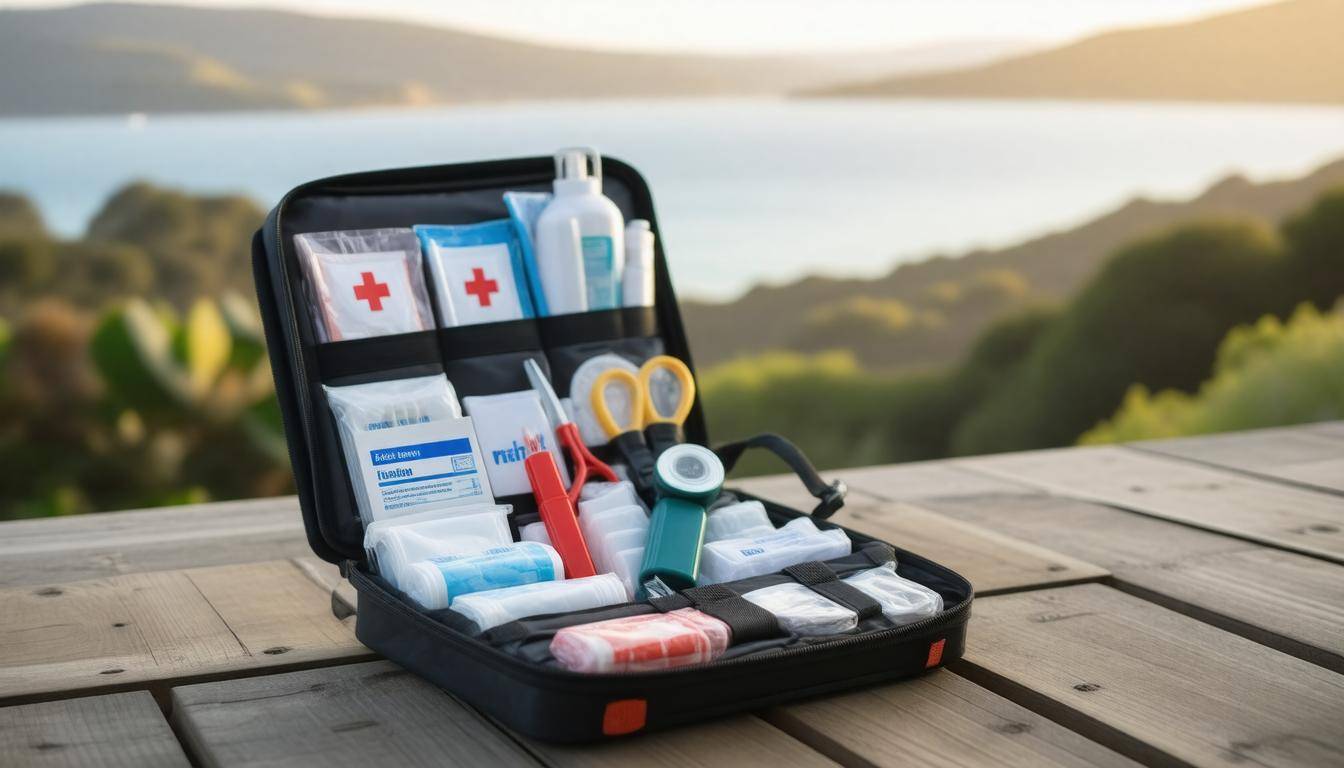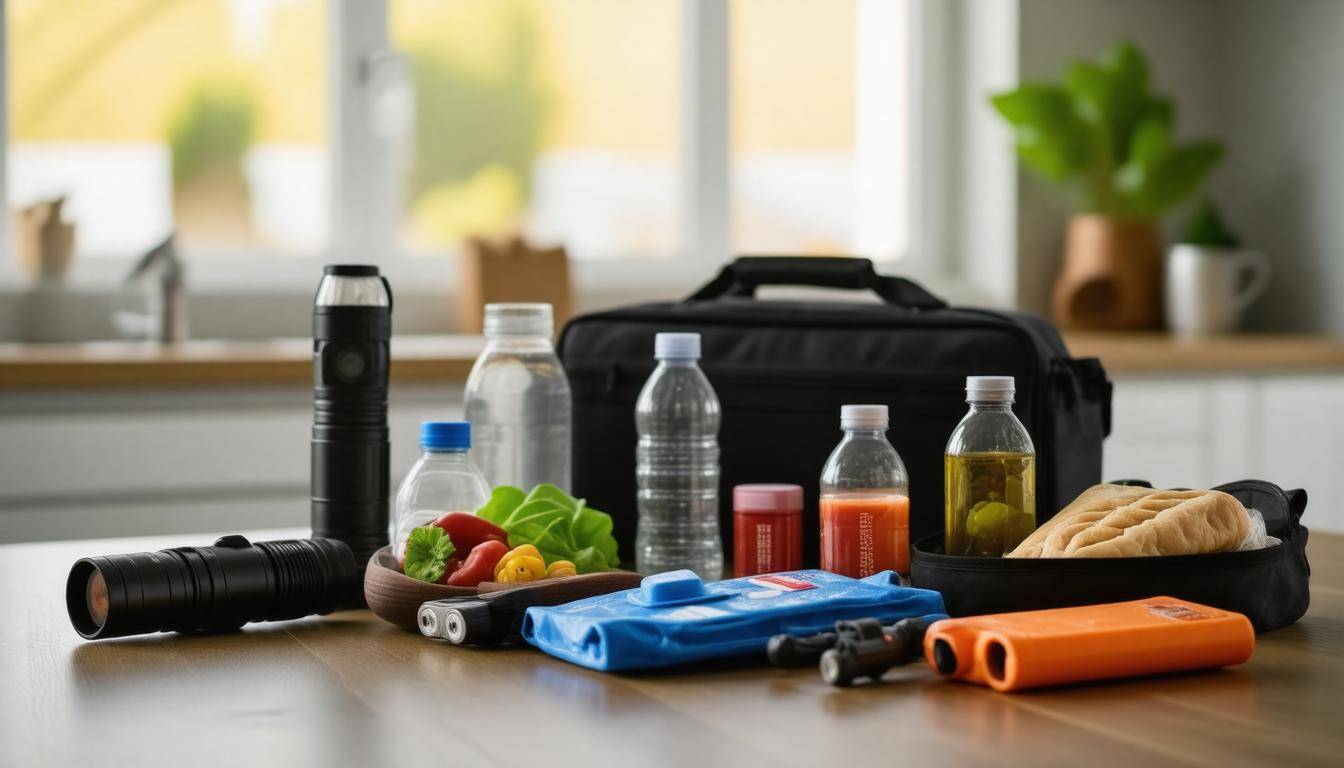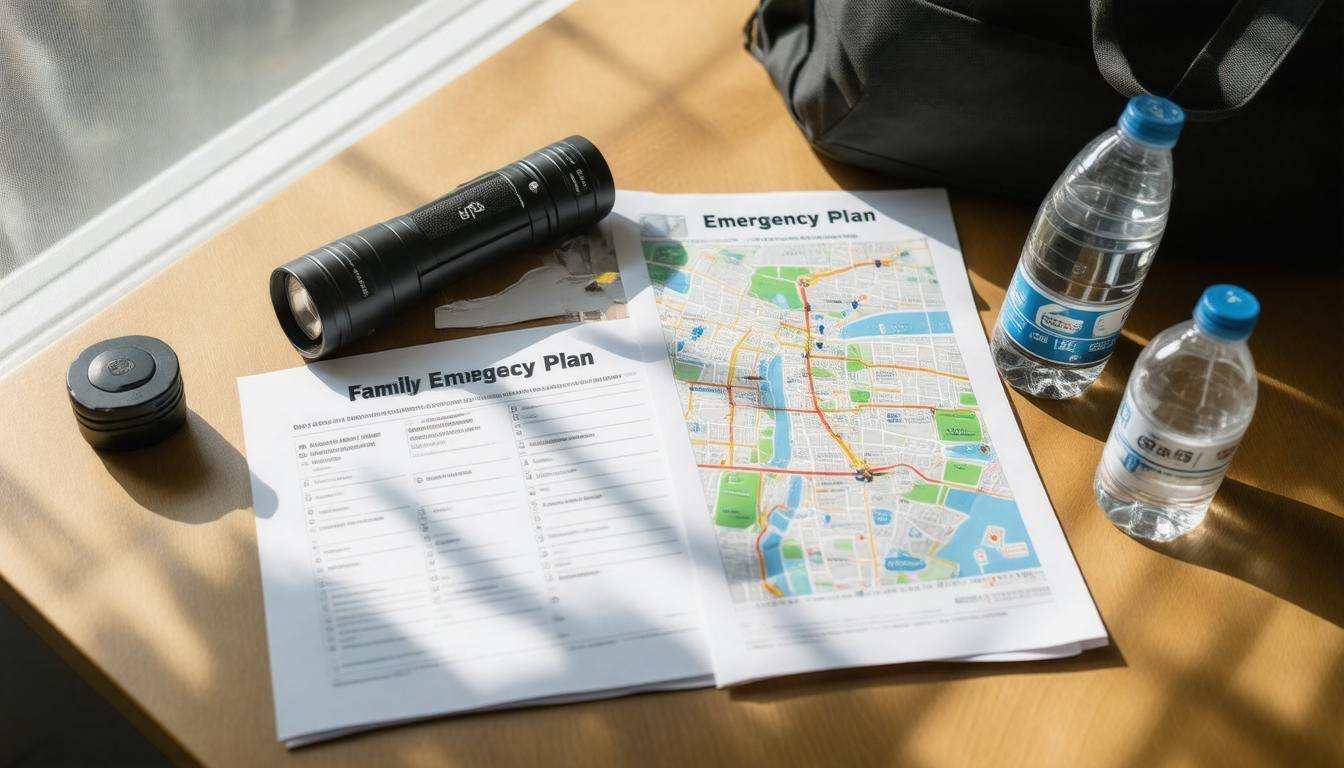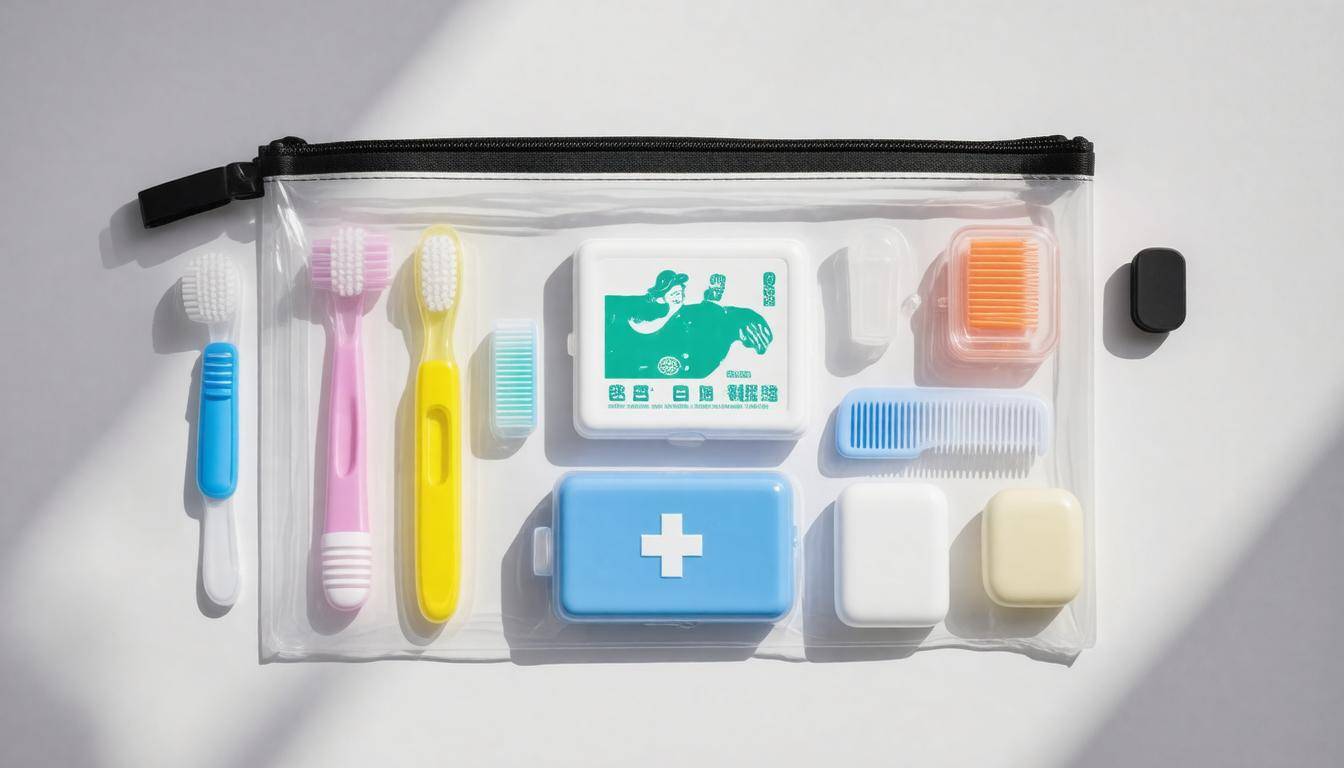When you think about living in Napier, the breathtaking ocean views and vibrant community come to mind—but there’s another reality we all have to face: earthquakes. For residents, it’s not just about enjoying the scenery; it’s crucial to be prepared for when the ground starts to shake. As someone who’s spent time researching and compiling essentials for emergency readiness, I understand firsthand how overwhelming it can feel. That’s why I’ve put together this guide to help you build your earthquake safety kit effectively. Having a well-equipped kit puts you in control and gives you peace of mind, knowing you’re ready to handle whatever comes your way. Let’s dive into what you’ll need!
A comprehensive earthquake safety kit for residents of Napier, North Island should include essentials such as non-perishable food items, bottled water (at least 3 days’ supply), a first aid kit, flashlight with extra batteries, a multi-tool, blankets, important documents in waterproof containers, and a portable phone charger. Be sure to regularly check and update your kit to ensure that all items are current and functional.

Essential Items for Earthquake Safety
First and foremost, start with water. It’s often overlooked but absolutely critical in any emergency. You should have at least one gallon of water per person per day for at least three days. In a situation where access to clean water is compromised, you’ll be grateful for every drop you’ve packed away.
Next, consider food—the kind that won’t spoil and doesn’t require cooking is best. Canned goods like soup or vegetables provide essential nutrition without needing refrigeration. Energy bars are another perfect choice since they’re lightweight and energy-dense. Make sure you also include a manual can opener. It might sound basic, but when you’re facing uncertainty, this little tool will allow you to access your food with ease.
Here’s a quick list of basic necessities that you should stock up:
- Water (1 gallon per person)
- Non-perishable food (canned goods, energy bars)
- Manual can opener
- Battery-powered radio to stay updated on emergency broadcasts
As you build your kit, don’t forget about communication and information gathering. A battery-powered radio keeps you informed in case the power goes out, allowing you to stay in touch with developments in your community during a crisis.
Moving on from sustenance, let’s not ignore the importance of having copies of essential documents in your kit. Paperwork like IDs, insurance details, and bank account information is crucial in emergencies. Store these important papers in a waterproof container to protect them from damage. You never know when circumstances could force you to evacuate quickly—having your critical documents accessible will ease some of the stress.
With these primary components in place, your earthquake safety kit will be equipped to address the essentials of hydration, nourishment, and documentation. Keeping these simple yet effective items ready contributes significantly to peace of mind in uncertain times.
Equipped with these essentials, it’s essential now to focus on formulating your escape plans and determining how best to respond when an earthquake occurs.
Evacuation Plans and Safety Procedures
Having a clear evacuation plan is not just a precaution; it’s a vital component of disaster preparedness. Knowing exactly what to do when every second counts can make all the difference. Just imagine the chaos that might ensue if everyone starts moving without a clear understanding of where to go or what to do. That’s why establishing designated safe spots in your home for “Drop, Cover, and Hold On” is fundamental.
Step-by-Step Evacuation Plan
First, it’s crucial to identify specific safe locations in each room—places where you can protect yourself from falling objects. These could be under sturdy tables, in doorways, or along interior walls away from windows. Each family member should understand these concepts so that even young children can respond appropriately during high-pressure situations.
The next step involves creating a Family Meeting Spot. This is a location outside your home that every family member is aware of and can easily access after exiting the house. It serves as a central point where everyone can regroup and account for each other after the earthquake. Ideally, this spot should be at least 500 feet away from your house to avoid potential hazards like debris.
Following this, you need to practice drills regularly. Regularly rehearsing your evacuation plan will help reinforce those critical actions into muscle memory. For instance, Jane, a Napier resident, understood this well—she held monthly family drills that made her kids comfortable with their roles and responsibilities. Through repetition, they learned not only where to go but also the importance of remaining calm amidst the chaos.
Another essential aspect of your evacuation plan involves learning community evacuation routes. Often, these routes will be predetermined by local authorities, particularly in zones prone to earthquakes or other natural disasters. Familiarize yourself with multiple routes in case some streets are blocked or unsafe immediately following the quake.
Once you’ve established and practiced your evacuation plan, having essential supplies ready at hand becomes crucial for navigating emergencies effectively. This preparation sets the stage for understanding how to care for injuries and emergencies should they arise.
First Aid Essentials

Being prepared for an earthquake or any disaster means being ready to respond to injuries, whether they are minor cuts or something more serious. Having a tailored first aid kit at your disposal increases your confidence in handling potential emergencies. The core items outlined earlier form the backbone of any effective first aid kit, but let’s explore their importance in depth.
Adhesive bandages are often the first line of defense against scrapes and small cuts. They not only help to keep the wound clean but also promote healing by protecting it from further irritation. Make sure to include multiple sizes, as children or adults can have different types of injury needs.
“The right adhesive bandage can do wonders, especially for kids, who may refuse care unless it involves cartoon-themed bandages!”
As we move along, sterile gauze pads become equally important. These pads are beneficial for larger wounds that may need more than just a simple bandage, particularly if bleeding is involved. Pair them with medical adhesive tape to secure them effectively over the wound, preventing dirt from entering and aiding in the healing process.
Pain management is another critical factor in providing first aid: this is where pain relievers come into play. Including non-prescription options like ibuprofen or acetaminophen ensures that you can alleviate discomfort while waiting for professional help if needed.
Cleaning and Tweezing
Cleaning wounds properly cannot be overstated. That’s why antiseptic wipes are a must-have item in every first aid kit; they allow you to clean wounds efficiently and reduce the risk of infection. The wipes are easy to use and eliminate the need for bottles that could spill—a real concern when mobility may be restricted after an earthquake.
Additionally, having tweezers handy will significantly help in removing splinters or debris from wounds without causing additional injury. Opt for stainless steel tweezers because they’re easier to clean compared to plastic ones and last longer.
Finishing Touches
Imagine needing to cut through clothing or packaging—this is where scissors become invaluable. Not all injuries present themselves conveniently; sometimes you need to remove clothing or supplies quickly. Invest in a pair of safety scissors designed specifically for first aid kits — with rounded edges, they make cutting easier without risking accidental injury.
Finally, having a reliable first aid manual cannot be highlighted enough. While many people feel comfortable with basic first aid procedures, emergencies can lead to panic — thus remembering the steps becomes difficult under pressure. A manual provides clear instructions and illustrations, ensuring that anyone assisting has guidance readily available.
With the core first aid essentials established, we now turn our attention to expanding your emergency preparations with essential items that will further support your safety and survival during an emergency.
Building a Survival Kit
A well-rounded survival kit encompasses more than just the basics like food and water; it ensures your ability to cope with the unknown. For instance, having extra survival tools can open up a world of possibilities when facing challenges. Imagine being stuck in a challenging scenario without the right gear to help yourself—it’s a daunting thought. This is why every robust survival kit should include specific tools that increase your chances of getting through tough situations.
Extra Survival Tools
Items such as a multi-tool, duct tape, and a whistle can be immensely useful in various circumstances. Consider the multi-tool: it’s not merely for fixing things but acts as a lifesaver for countless small tasks. Need to open a can or repair a broken item? This tool has got you covered. Additionally, duct tape is famous for its versatility—it’s there to quickly patch up your gear or even temporarily waterproof surfaces if you find yourself exposed to the elements.
A whistle is another indispensable item within this toolkit; it serves as an effective signaling device for help. It conveys sound far better than your voice ever could, making it easier for rescuers to locate you should you find yourself trapped.
| Item | Use Case |
|---|---|
| Multi-tool | Versatile tool for repairs |
| Duct Tape | Temporary fix and waterproofing |
| Whistle | Signal for help |
Ensuring your survival kit also covers lighting, hygiene, and personal protection adds layers of preparedness that are hard to overlook.
While tools are critical, light sources are equally vital. Flashlights or headlamps powered by long-lasting batteries can illuminate dark environments, providing safety and reassurance during tumultuous times. Equally important is your hygiene; including disinfectant wipes or hand sanitizer can help maintain cleanliness and reduce the risk of infections when access to fresh water is compromised. It’s astounding how minor comforts can significantly boost morale during trying scenarios.
Additionally, personal protection items like masks or gloves won’t just help keep you clean but can also shield against harmful allergens or contaminants following an earthquake or similar disaster. Thinking ahead about these details allows you to tailor your kit specifically to meet your needs and those of your family during emergencies.
As we move forward, it’s crucial to examine how these aspects interconnect with other essential resources needed in emergency situations.
Lighting, Hygiene, and Protection Needs
During a crisis, proper lighting, hygiene, and protection become paramount. When the lights go out, it’s easy to feel disoriented and anxious; thus having reliable lighting options can significantly alleviate that stress.
Flashlights are a must-have, and it’s wise to invest in quality ones that offer both brightness and battery efficiency. I recommend keeping several flashlights throughout your home and vehicle along with extra batteries. Additionally, consider incorporating solar-powered lanterns into your kit. Not only do they provide a longer-lasting light source, but they also charge during the day so you won’t have to rely solely on batteries.
For added safety, ensure that a fire extinguisher is included in your kit to handle any unforeseen flare-ups while heating food or when lighting candles.
Hygiene may seem trivial amid chaos, but it plays a crucial role in both mental and physical health during challenging times. Imagine being stuck in an emergency situation with no clean water or sanitation supplies—this can lead to stress and even health risks. Therefore, it’s vital to pack items such as hand sanitizer, which should contain at least 60% alcohol content for effective germ-killing.
Moist towelettes are another great choice for freshening up when traditional facilities are unavailable; they’re portable and effective for quick clean-ups. Lastly, don’t forget plastic bags for waste disposal. Not only do these help keep your area tidy, but they also prevent any potential contamination from accumulating.
Alongside hygiene needs, protection is equally important in maintaining your safety during emergencies.
Depending on the nature of the disaster, debris could pose a significant risk. To protect yourself effectively, masks are essential for filtering dust and smoke from the air; this is particularly crucial if you’re dealing with fires or other airborne pollutants. Choose masks that offer a secure fit for maximum protection.
It’s also advisable to include work gloves in your kit. Durable gloves can protect your hands against cuts or scrapes while moving debris or handling materials that may be hazardous. In addition to gloves, wearing sturdy shoes is non-negotiable during an emergency; they shield your feet from injury and provide better stability when navigating uneven terrain.
With all these essentials combined—in terms of lighting, hygiene, and protective gear—you enhance your preparedness for any disaster you may face while ensuring comfort and safety throughout the experience. Now that we’ve covered these important aspects of readiness, let’s explore how to put together an effective kit tailored to these needs.
Assembly Guide for Safety Kits
Proper assembly ensures that your kit is organized and ready to be used at a moment’s notice. Imagine you’re faced with an emergency—wouldn’t it be comforting to know exactly where to find what you need? The first step is to ensure your items are categorized neatly, allowing for quick access when every second counts.
Organize by Categories
Begin by dividing your items into distinct categories: food and water, first aid, survival tools, and hygiene supplies. Each category serves a vital purpose in sustaining you during challenging times. For instance, food and water must be easily identifiable, as they are essential for basic survival.
Tip: Place each category in separate, labeled bags or containers. This will save you time later and help you quickly assess what you have on hand. It’s like organizing a toolbox—you wouldn’t want to rummage through a heap of screws just to find the hammer!
Once you’ve sorted everything into categories, create a master list detailing what’s included in each bag so that restocking becomes easier after use. It’s easy to forget what you had once items are used up or shifted around, making this simple step invaluable.
Choose the Right Bag
The next consideration is selecting an appropriate bag for your kit. A large, sturdy backpack is optimal for portability; however, think about practicality too—keeping one in your car is an excellent backup plan in case you’re away from home when disaster strikes.
When choosing your backpack, ensure it has multiple compartments. This keeps items from shifting around during travel and enables quicker access to crucial supplies without disrupting the entire setup.
Additionally, having a smaller secondary kit stored in your vehicle can provide peace of mind when you’re on the go. Picture unexpectedly getting stuck in traffic during an unforeseen event—having essentials within arm’s reach could make all the difference.
With these initial assembly steps in place, it’s also crucial to consider the specific risks associated with living in Napier. Tailoring your kit’s contents around local guidelines and potential hazards will further enhance its effectiveness and efficiency when it matters most.
Earthquake Guidelines for Napier

Living in Napier, you’re not just a resident of a vibrant coastal city; you’re also part of a community aware of its unique seismic risks. Given that Napier lies along the Pacific Ring of Fire, there’s a consistent need for vigilance regarding earthquake safety. This isn’t merely about preparing your earthquake kit; it involves understanding how to act when the earth begins to shake beneath you.
Local Risk Assessment
Napier is indeed prone to seismic activity, and residents should familiarize themselves with guidelines specifically designed for earthquake-prone areas. The GeoNet and Civil Defence offer valuable resources tailored for our region. Their recommendations highlight not just the frequency of tremors but also the potential severity. By regularly checking updates from these organizations, you can ensure that your actions remain aligned with current safety advisories.
It’s essential to recognize that every piece of information you gather contributes to a heightened state of readiness—knowing what to expect helps eliminate panic during emergencies.
In addition to comprehending local risks, it is crucial to devise a personal response plan. Think about where you will take cover during an earthquake—under sturdy furniture like tables or desks is ideal to shield yourself from falling debris. Equally critical is establishing a meeting spot for your family members in case you become separated—designate an easily recognizable location outside your home where everyone can rendezvous.
As we navigate through these preparations, consider not just your personal safety but also how you can assist those around you during an emergency situation.
Community Preparedness
Engaging with your neighbors can foster a more robust community readiness. Hosting discussion nights or workshops centered around disaster preparedness encourages sharing useful tips and resources. You might discover that someone down the street has experience in emergency services or first aid training, which could be beneficial to learn from.
Remember, safety in numbers applies even in disaster scenarios; being part of a prepared community multiplies everyone’s strength and capability during times of crisis.
Another critical aspect is regular practice and drills within your household—to reinforce the steps you’ve outlined, hold periodic drills so everyone remembers their roles and responses instinctively. Familiarizing yourself and your family with the plan will ease anxiety and enhance confidence when earthquakes strike.
Preparing effectively requires not only understanding your surroundings but also ensuring you’re fully equipped with knowledge and practical skills that influence behavior during seismic events.
With proactive measures in place, residents can better navigate both individual and communal safety concerns as we move forward to discuss access to vital support systems available in our area.
Local Resources and Aid Information
Access to local resources can be lifesaving during and after an earthquake. Knowing whom to contact and where to go in case of emergency can significantly improve your response when disaster strikes. Equip yourself with reliable information so that you can act swiftly should an earthquake occur.
Emergency Contacts
Having a list of emergency contacts, including local Civil Defence, emergency services, and nearby hospitals, can provide invaluable support. Make sure this list is easily accessible; consider keeping it on your refrigerator or saved in your phone under “Emergency Contacts.”
In an emergency situation, every second counts, so being able to find a number quickly can save precious time. Familiarize yourself with the locations of the nearest Civil Defence centres. These centres play a vital role during emergencies as they act as operations hubs for coordinating rescue efforts. Don’t forget to include any family members’ numbers who may live nearby.
Community Support
Another key aspect of preparedness involves engaging with community support systems. Getting involved in local community preparedness groups enhances your awareness and strengthens your network. These groups often hold training sessions on first aid, search and rescue techniques, and other critical skills that can empower you during crises.
“Building strong relationships with neighbors helped us all feel more secure,” said one community member reflecting on past experiences with natural disasters.
Staying updated on local shelter locations is equally important; knowing where to go if your home becomes uninhabitable can provide peace of mind. Many communities have designated shelters equipped with supplies such as food, water, and bedding, making a world of difference when the unexpected occurs.
Local resident Tom mentions, “During the last quake, the community shelter provided food and blankets while we were waiting for help.” His words resonate deeply regarding the importance of preparedness; his experience illustrates how leveraging local resources—both formal and informal—can create a supportive environment amidst turmoil.
By understanding the importance of local resources and building connections within your community, you can cultivate comfort and resilience during challenging times. Taking proactive steps now to prepare for potential earthquakes safeguards yourself and contributes to a stronger, more prepared community overall.











